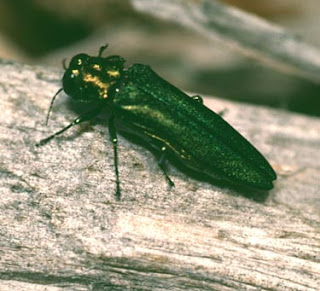 Mark Widrlechner is a man not easily intimidated, so the challenge of saving a species from extinction is right up his alley. As Maleanie S. Welte reports for the Associated Press, the native ash tree is worth $25 billion as timber and is used in neighborhood landscaping across the country. At the same time there, is a determined bug that is killing the trees by the millions in thirteen states, unless Widrlechner can stop them.
Mark Widrlechner is a man not easily intimidated, so the challenge of saving a species from extinction is right up his alley. As Maleanie S. Welte reports for the Associated Press, the native ash tree is worth $25 billion as timber and is used in neighborhood landscaping across the country. At the same time there, is a determined bug that is killing the trees by the millions in thirteen states, unless Widrlechner can stop them.Widrlechner is a horticulturist for the U.S. Department of Agriculture’s (USDA) Agriculture Research Service (ARS) in Iowa. As part of his efforts Widrlechner has collected “tens of millions of ash seeds from across the U.S. that can be frozen and ready to plant when researchers figure out how to kill or control the emerald ash borer,” Welte writes.
The seeds can only be hand-picked from the branches and only in the fall, but the scientists are more than willing to do this to prevent the ash from going to the way of the American elm, chestnut, and butternut trees. All three of which were nearly whipped out by disease.
“Widrlechner said the ash borer is especially devastating because it can kill very young trees and reduce the possibility that the species develop a tolerance.” ‘“This one to me looks like it's much more likely to lead to extinction if we don't do anything about it,’ predicted Widrlechner, who also is a professor at Iowa State University in Ames.”
Commercially ash trees are used to make baseball bats and cabinet fixtures and other such products. The tree is ubiquitous in parts of the Midwestern landscape.
‘The eastern U.S. produces nearly 114 million board feet of ash saw timber valued at $25 billion, according to the 2009 manual by the Department of Agriculture on the emerald ash borer. The potential impact on the urban landscape could include 30 million to 90 million trees and cause $20 billion to $60 billion in damage, the report estimated. The insect is native to Asia and was first identified in the U.S. in 2002, when it was spotted in Michigan. It's now found in Illinois, Indiana, Kentucky, Maryland, Michigan, Minnesota, Missouri, New York, Ohio, Pennsylvania, Virginia, West Virginia and Wisconsin.The larvae from the adult beetles are the problem. They “drill into trees, eat through the vascular tissue and stop the flow of water.” It may take an infested tree years to finally die, while the emerging beetles spread elsewhere.
The insect can’t be stopped by quarantine. So new methods and techniques have to be developed. Welte reports that the seed collection project that began back in 2007 in New England, has spread slowly across the Midwest. The project includes several federal agencies and Native American tribes. They hope to collect the requisite number and type of seeds to reflect the current density and diversity of the population.
Preventing the ash from going the way of its forbearers may lie in the planting. According to Noel Schneeberger, and entomologist with the U.S. Forest Service, ‘“We need to pay attention to planting the right trees for the right place in urban areas and diversify the urban canopy . . . We don't plant one street full of ash, for example, we plant a variety of species.”’
For the ash’s sake let’s hope we’ve learned from previous mistakes.
To read the AP article click here.
Posted: 10/09/09


